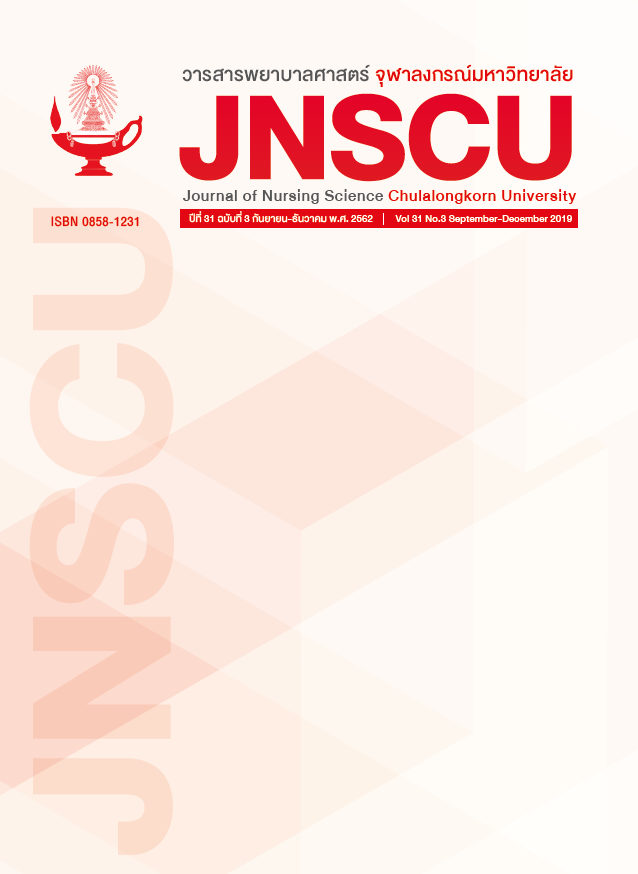ผลของโปรแกรมเสริมสร้างความสามารถในการดูแลของครอบครัว ต่ออาการออทิสติกของเด็กออทิสติกวัยก่อนเรียน
คำสำคัญ:
ความสามารถในการดูแล, อาการออทิสติก, เด็กออทิสติกวัยก่อนเรียนบทคัดย่อ
วัตถุประสงค์: เพื่อเปรียบเทียบอาการออทิสติกของเด็กออทิสติกวัยก่อนเรียนก่อนและหลังได้รับโปรแกรมเสริมสร้างความสามารถในการดูแลของครอบครัว และเปรียบเทียบอาการออทิสติกของเด็กออทิสติกวัยก่อนเรียนที่ได้รับโปรแกรมเสริมสร้างความสามารถในการดูแลของครอบครัวกับกลุ่มที่ได้รับการพยาบาลตามปกติ
รูปแบบการวิจัย: การวิจัยกึ่งทดลอง
วิธีดำเนินการวิจัย: กลุ่มตัวอย่างคือ เด็กที่ออทิสติกอายุ 3-6 ปี และครอบครัวที่มารับบริการแผนกผู้ป่วยนอก โรงพยาบาลยุวประสาทไวทโยปถัมภ์ ซึ่งมีคุณสมบัติตามเกณฑ์ โดยได้รับการจับคู่ (Matched pair) และการสุ่มเข้ากลุ่มทดลองและกลุ่มควบคุม จำนวนกลุ่มละ 20 คู่ กลุ่มทดลองได้รับการเข้าร่วมโปรแกรมเสริมสร้างความสามารถในการดูแลของครอบครัว เป็นระยะเวลา 4 สัปดาห์ ส่วนกลุ่มควบคุมได้รับการพยาบาลตามปกติ เครื่องมือที่ใช้ในการทดลอง คือ โปรแกรมเสริมสร้างความสามารถในการดูแลของครอบครัว และคู่มือการดูแลเด็กออทิสติก สำหรับครอบครัว เก็บข้อมูลโดยใช้แบบประเมินอาการรุนแรงของโรคออทิซึม และแบบประเมินพลังอำนาจ มีค่าดัชนีความตรงตามเนื้อหา เท่ากับ .92 และ .80 ตามลำดับ และมีค่าความเที่ยงสัมประสิทธิ์แอลฟาครอนบาค เท่ากับ .96 และ .89 ตามลำดับ วิเคราะห์ข้อมูลโดยใช้สถิติทดสอบที (t-test)
ผลการวิจัย 1) คะแนนเฉลี่ยอาการออทิสติกของกลุ่มที่ได้รับโปรแกรมเสริมสร้างความสามารถในการดูแลของครอบครัวน้อยกว่าก่อนได้รับโปรแกรม อย่างมีนัยสำคัญทางสถิติที่ระดับ .01 และ 2) คะแนนเฉลี่ยอาการออทิสติกของกลุ่มที่ได้รับโปรแกรมเสริมสร้างความสามารถในการดูแลของครอบครัวลดลงมากกว่ากลุ่มที่ได้รับการพยาบาลตามปกติ อย่างมีนัยสำคัญทางสถิติที่ระดับ .01
สรุป: การใช้โปรแกรมเสริมสร้างความสามารถในการดูแลของครอบครัวสามารถทำให้อาการออทิสติกของเด็กออทิสติกวัยก่อนเรียนลดลงได้ ซึ่งเป็นไปตามสมมติฐานที่ตั้งไว้
เอกสารอ้างอิง
Elsabbagh M, Divan G, Koh YJ, Kim YS, Kauchali S, Marcín C, et al. Global prevalence of autism and other
pervasive developmental disorders. Autism research 2012; 5(3): 160-79.
Zablotsky B, Black LI, Maenner MJ, Schieve LA, Blumberg SJ. Estimated prevalence of autism and other developmental disabilities following questionnaire changes in the 2014 National Health
Interview Survey [Internet]. 2015 [cited 2017 Dec 20].
Available from: https://www.cdc.gov/ncbddd/autism/ data.html.
Carter AS, Black DO, Tewani S, Connolly CE, Kadlec MB, Tager-Flusberg H. Sex differences in toddlers with autism spectrum disorders. Journal of autism and developmental disorders 2007; 37(1): 86-97.
American Psychiatric Association. Diagnostic and statistical manual of mental disorders (DSM-5). 5th ed. Washington, D.C.: American Psychiatric Pub; 2013.
Rimland B, Edelson SM. Autism treatment evaluation checklist (ATEC). SanDiego: Autism Research Institute; 2000. Retrieved October, 23; 2006.
Zablotsky B, Bramlett M, Blumberg SJ. Factors associated with parental rating of condition severity for children with autism spectrum disorder. Disability and Health Journal 2015; 8(4): 626-34.
Steinman GD, Mankuta D, Zuckerman R, Gray F. The cause of autism: Concepts and Misconceptions. New York: Baffin Book Publishing; 2014.
Missouri Autism Guidelines Initiative. Autism spectrum disorders: Guide to evidencebased interventions: Missouri Foundation for Health: St. Louis and Springfiled, MO; 2012.
Siriratlekha T. The manaul of caring for patients with autism spectrum disorder. 5 ed. Bangkok: National office of Buddhism; 2012.
Oono IP, Honey EJ, McConachie H. Parentmediated early intervention for young children with autism spectrum disorders (ASD). Evidence‐Based Child Health: A Cochrane Review Journal 2013; 8(6): 2380-479.
Meirsschaut M, Roeyers H, Warreyn P. Parenting in families with a child with autism spectrum disorder and a typically developing child: Mothers’ experiences and cognitions. Research in Autism Spectrum Disorders 2010; 4(4): 661-9.
Stillman W. Empowered autism parenting: celebrating (and defending) your child's place in the world. San Francisco: Jossey Bass; 2009.
Webster M, Whitmeyer JM. Applications of theories of group processes. SociologicalTheory 2001; 19(3): 250-70.
Lewin K. Frontiers in group dynamics: Concept, method and reality in social science; social equilibria and social change. Human relations 1947; 1(1):5-41.
Ebrahimi H, Malek A, Babapoor J, Abdorrahmani N. Empowerment of mothers in raising and caring of child
with autism spectrum disorder. International research journal of applied and basic sciences 2013; 4(10): 3109-13.
Miller JF. Coping with chronic illness: overcoming powerlessness. 2nd ed. Philadelphia: Davis; 2000.
Gibson. The process of empowerment in mothers of chronically ill children. Journal of advanced nursing 1995; 21(6):1201-10.
Suprajitno S. EFFECT OF FAMILY EMPOWERMENT IN ENHANCING THE CAPABILITIES OF CHILDREN WITH
AUTISM. Belitung Nursing Journal 2017; 3(5): 533-40.
Myers SM, Johnson CP. Management of Children With Autism Spectrum Disorders. Pediatrics 2007; 120(5). 1162-82.
ดาวน์โหลด
เผยแพร่แล้ว
ฉบับ
ประเภทบทความ
สัญญาอนุญาต
ลิขสิทธิ์ของบทความที่ตีพิมพ์เป็นของวารสารพยาบาลศาสตร์ จุฬาลงกรณ์มหาวิทยาลัย ทั้งฉบับตีพิมพ์เป็นรูปเล่มและเอกสารออนไลน์



